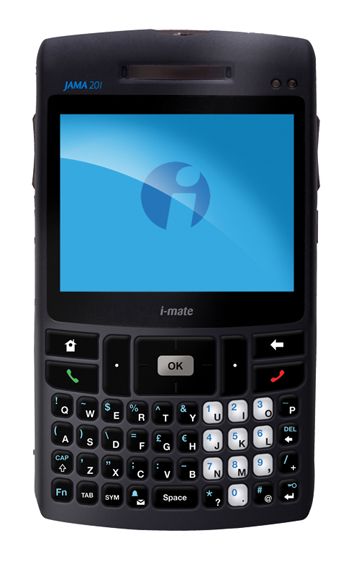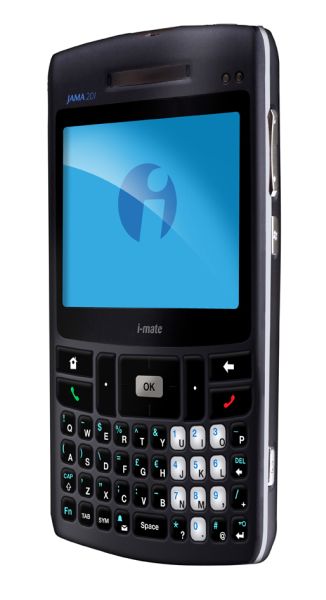i-Mate Jama 201 Review
i-Mate Jama 201
This slim, light smartphone will turn heads, but will it find its way into jacket pockets?

Verdict
It’s a sad fact that much of the tech on sale these days is still targeted at men. Many smartphones, laptops, PCs, sat-nav devices seem very masculine, not only because they’re toys and fun to play with, but because of the way they’re designed.
Take my wife (come on, it’s Christmas, I’m allowed one Les Dawson gag…): whenever I wave a new gadget at her with a silly grin on my face that says “isn’t this cool?”, the response is normally distinctly luke warm. “It’s too masculine,” she moans, a criticism that, just recently, has been aimed firmly at the smartphones I’ve had in for review.
When you sit down and think about it, she’s right, of course. They’re usually quite big, squarish and grey or black. Even the names are macho: the X600, the 503G, the TyTN II (for pity’s sake!)… you get the picture. So it’s refreshing to see something that elicits something different to the wrinkled-up nose and look of disdain. I’m talking about i-Mate’s latest BlackBerry-style smartphone, the Jama 201.
It’s easy to see why. Though the Jama is still clad in rather masculine black clothes, and has a pretty geeky-sounding name, it’s very, very slim. At 14mm thick it’s only a touch thicker than a biro, and it’s not too wide (63mm), tall (113mm) or heavy (152g) either. Despite the fact that it’s the same size on paper as the BlackBerry 8800 this just feels slimmer – in fact the closest phone I can think of to the 201 in terms of pocketability (or should I say handbag friendliness) is Samsung’s i600, but this i-Mate beats it hands down in terms of its chic appeal.
The 201 is also a very tactile device. The whole chassis is coated in that lovely rubbery, soft-touch plastic which, as well as feeling soft and smooth under your fingertips, also means when you’re typing away on its QWERTY keyboard it feels secure in your hands, unlike a number of soap-bar phones I could mention.
In terms of ease of use, these compact dimensions could have an impact, but surprisingly, i-Mate has done a decent job here as well. The keyboard is absolutely tiny and smaller than that on a BlackBerry 8800, for instance, and, if you’ve got big, builder’s thumbs, likely to be rather difficult to use. But I found that, once I’d got used to the size of the keys, typing short email messages and texts was surprisingly easy. The square keys have just enough space between them to prevent you accidentally striking neighbouring characters, and they have a positive click to them that means you know exactly when you’ve pressed or not pressed a key successfully. It can’t match the superb design of the BlackBerry 8800’s keyboard, but it’s not that far behind in its usability. 
The button cluster above the keyboard and below the 320 x 240, 2.4in screen, is also reasonably well done. All the keys are well-labelled and are easy yet firm to click – just like the keys on the keyboard. The five-way d-pad is a touch fiddly, and again can’t match the 8800s scrolling ‘pearl’, but it’s by no means awful. I’ve used a lot worse than this.
Where the Jama 201 is not strong as I’d like, however, is on the features front. Most notable among the omissions is the lack of 3G or HSDPA internet; you’re stuck with GPRS with EDGE for browsing the internet and downloading email. It doesn’t sound like much, but try downloading attachments larger than a few Kb – a PDF file, for instance, and you’ll quickly become frustrated.
It’s just a tri-band phone too, with no support for the 850 GSM band so you can’t use the phone in the US if your business happens to take you there. And you don’t get the luxury extras you do with the flagship BlackBerry phones or other top-end handelds. There’s Bluetooth, but it’s not the faster version 2.0. There’s no GPS receiver, nor is there a Wi-Fi adaptor, and the paucity of advanced features extends to a bog-standard 2.0 megapixel digital camera, which is equipped with neither a flash nor a self-portrait mirror. It looks positively stone-age next to a TyTN II and even Samsung’s i600 which has been around some time now and boasts HSDPA where this has none.
Finally, the 201 is powered by a rather weedy-looking 300MHz Samsung processor, coupled with 128MB of ROM and 64MB of RAM. It doesn’t make for the snappiest-feeling performance when switching from application to application, but contacts lookups in my large test database, which contains more than 500 entries, are pretty much instantaneous.
There is an upside to the lack of features though. Sticking to just GPRS instead of the more power-hungry 3G and HSDPA connection, seems to contribute to impressive battery life. Despite the seemingly low capacity 1,110mAh lithium ion battery and rather average-sounding quoted four hours talktime and 150 hours standby, I found that a single charge went a long way with the Jama 201 – further than with my favoured TyTN II. I was able to go three to four days out of it at a time, and that includes making frequent phone calls, browsing the internet and picking up email from my Exchange Server.
”’Verdict”’
But despite the fact that my wife doesn’t think it’s bad, the i-Mate Jama 201 isn’t all things to all men and women. It’s well designed, slim, light and in general a pleasant device to use. The keyboard is good, making typing out emails and SMS messages a simple task and battery life is top drawer.
If all you want is a decent qwerty keyboard for messaging and the odd bit of internet browsing, it’s a competent device. But for me it’s lacking in just too many other areas to compete with the latest smartphones on the market. No HSDPA or 3G, no GPS, no quad-band GSM and no decent camera mean that, despite a reasonable price, it fails to gain the Trusted Reviews seal of approval.
How we test phones
We test every mobile phone we review thoroughly. We use industry standard tests to compare features properly and we use the phone as our main device over the review period. We’ll always tell you what we find and we never, ever, accept money to review a product.
Trusted Score
Score in detail
-
Usability 8
-
Value 7
-
Features 6

